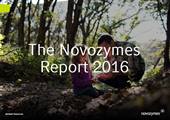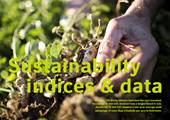
Climate change
Novozymes has adopted three efficiency/intensity targets that measure performance improvements against the base year 2014. The efficiency/intensity is measured as consumption/emissions divided by gross profitA company's total revenue (equivalent to total sales) minus the cost of goods sold.. In 2016, consumption/emissions increased more than gross profit, resulting in reduced performance compared with 2015. Novozymes' CO2 intensity reduction compared with the base year 2014 fell from 17% in 2015 to 16% in 2016.
Novozymes’ impact on climate change should also take into account the net positive carbon footprint that its products generate. In 2016, Novozymes’ customers avoided an estimated 69 million tons of CO2 emissions by applying Novozymes’ products, compared with 60 million tons in 2015. The savings achieved are equivalent to taking approximately 30 million cars off the road.
Energy
In 2016, the energy efficiency improvement compared with the base year 2014 was 10% – a reduction from 15% in 2015. This decrease stems from operational challenges in Novozymes' fermentation facilities and increased capacity utilization, both of which required more energy.
As in 2015, Novozymes obtained 24% of its energy from renewable sources in 2016, mostly from offshore wind farms in Denmark.
Water
In 2016, the water efficiency improvement was 6% compared with the base year 2014. In 2015, the improvement was 9%. The decrease was due to high capacity utilization, changed product mix and ongoing challenges in the system for reusing water in Denmark.
Waste
In 2016, Novozymes’ production sites across the world generated 13,000 tons of solid waste, of which 44% was recycled, compared with 50% in 2015.
Novozymes recovered more than 97% of the biomassOrganic material, predominantly plants or plant residues. generated as a by-product of its production processes, compared with 98% in 2015. All recovered biomass is either sent for composting or is converted and sold as NovoGro®, an organic agricultural fertilizer.
Environmental compliance
In 2016, 37 breaches of regulatory limits were recorded worldwide, compared with 27 in 2015. Most of these breaches are minor and relate to wastewater treatment and soil contamination. Novozymes has agreed on or is in the process of negotiating action plans with the relevant authorities to address these incidents.
In addition, the company received nine complaints from neighbors in 2016, compared with 11 in 2015, mostly related to odors and noise.


